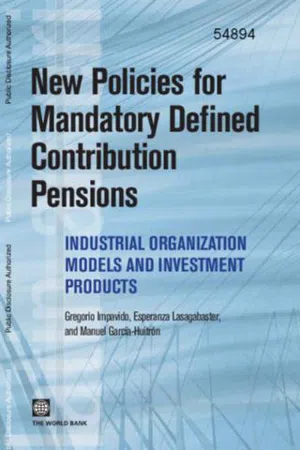
New Policies for Mandatory Defined Contribution Pensions
Industrial Organization Models and Investment Products
- English
- PDF
- Available on iOS & Android
New Policies for Mandatory Defined Contribution Pensions
Industrial Organization Models and Investment Products
About This Book
The recent financial crisis is challenging the reform approach to mandated pension a scheme that has emerged over recent decades across the world. This reform approach is characterized by a move toward multi-pillar pension systems and includes the creation or extension of a mandatory funded pillar with defined contribution design. The rationale and viability of such a pillar is contingent on an enabling environment and the delivery of high risk-adjusted net rates of return that beat the natural benchmark, which is the internal rate of return that an unfunded mandated scheme is able to achieve. Two key aspects of mandated and funded defined contribution schemes have been under discussion and investigation since dedicated pension funds were created: (a) the high fees levied by privately organized pension funds and the consequence for the net rate of return; and (b) the investment products of these funds and their capability to address the investment risks and to deliver the expected retirement income in a life-cycle context. To this end, country policies have experimented with a variety of approaches to improve outcomes with some important leads but overall modest results. This book proposes to take a fresh and highly innovative look at both policy issues. It suggests stepping back and looking at the underlying causes of the issues at stake instead of merely trying to address their symptoms. In addressing the high fees of pension funds, it focuses on the less-than-ideal conditions inert consumers facing firms with market powers and proposes to apply solutions derived from industrial organization models and pricing methods that better reflect the cost structure of the supply of pension services. In addressing the investment risks, it asks how to improve fund managers' risk-adjusted investment performance when participants are inert.
Frequently asked questions
Information
Table of contents
- Contents
- Foreword
- Acknowledgments
- Abbreviations
- 1 Introduction
- 2 Industrial Organization Issues and Their Consequences
- 3 Narrowly Focused Policies or Alternative Industrial Models?
- 4 Investment Choice and the Design of Investment Options
- 5 Conclusions
- Index
- 2.1 Are Quasi-Markets Efficient?
- 2.2 Behavioral Economics Lessons for Mandatory DC Pensions
- 2.3 What Are the Effects of Switching Costs in Pension Markets?
- 2.4 Barriers to Entry in Pension Markets
- 2.5 Governance Structure of Pension Firms in Selected Emerging Markets
- 2.6 Marketing as a Means of Preserving and Increasing Market Power
- 3.1 Additional Motivations for Earnings- and Asset-Related Fee Bases
- 3.2 Price Discrimination Promoting Efficiency in Supply
- 3.3 Who Really Benefits from Redistribution?
- 3.4 Switching Regulations That Do Not Eliminate Marketing Incentives
- 3A.1 Political Influence in Asset Management
- 4.1 Life-Cycle Funds: Theoretical Underpinnings
- 4B.1 Individuals’ Attitude to Risk
- 4B.2 Equity Risk Premium in the United States
- 4C.1 Liability-Driven Investment Strategies: How Are They Implemented?
- 1.1 Assets in DB and DC Private Plans, Various Years
- 1.2 Role of Financial Assets in Overall Income Retirement Financing
- 2.1 Latin America: 25-Year Assets under Management, Equivalent Fees (Dispersion)
- 2.2 Latin America: 40-Year Assets under Management, Equivalent Fees (Dispersion)
- 2.3 Eastern Europe: 25-Year Assets under Management, Equivalent Fees (Dispersion)
- 2.4 Eastern Europe: 40-Year Assets under Management, Equivalent Fees (Dispersion)
- 2.5 Returns on Equity of Pension Firms in Select Latin American Countries, 1995–2005
- 2.6 Returns on Equity of Pension Firms and Banks, 2005
- 2B.1 Consumer Confusion in the AFORE Market
- 4.1 Chile Pension System Holdings as a Share of Gross Domestic Product, 1996–2008
- 4B.1 Mean Reversion and Variability of Returns in the United States, 1980–98
- 4B.2 Career Salary Profiles for Male Workers in the United Kingdom, Mid-1990s
- 4B.3 Career Salary Profiles for Female Workers in the United Kingdom, Mid-1990s
- 4C.1 Lifestyling without Deferred Annuities
- 4C.2 Lifestyling with Deferred Annuities, No Bequest Motive
- 4C.3 Lifestyling with Deferred Annuities, Bequest Motive
- 2.1 Number of Transfers across Pension Firms, 2000–07
- 2.2 Operational Expenses in Latin America, 2000 and 2007
- 2.3 Concentration Indicators in Selected Emerging Markets, Selected Years
- 2.4 Concentration and Market Power in Latin America, 1998–2007
- 2.5 Average First-Floor Fees in Latin American Countries, 2006
- 2.6 Latin America: 25-Year Assets under Management, Equivalent Fees
- 2.7 Latin America: 40-Year Assets under Management, Equivalent Fees
- 2.8 Eastern Europe: 25- and 40-Year Assets under Management, Equivalent Fees
- 2.9 Mutual Fund Fees and Expenses in the United States, 2000–05
- 3.1 Price Regulation in Selected Countries, 2008
- 3.2 Fees Charged by KiwiSaver Default Providers, 2007
- 4.1 Investment Choices in the Australian Superannuation System
- 4.2 Asset Allocation of Default Investment Options in the Australian Superannuation System
- 4.3 Maximum Equity Investment Limits for Multifunds in Chile, Mexico, and Peru
- 4.4 Age-Dependent Default Options in Chile
- 4.5 Age-Dependent Default Options in Mexico
- 4.6 Age-Dependent Default Options in Peru
- 4.7 Mandatory DC Pension Assets in Selected Emerging Markets
- 4.8 Equity Shares in Total Pension Portfolio
- 4.9 Performance of Mandatory Defined Contribution Pension Systems in Selected Emerging Markets
- 4.10 Performance of Multifunds’ Investment Options in Latin America
- 4.11 Asset Allocation by Type of Fund in Chile, December 2008
- 4A.1 Key Maximum Investment Limits for Chilean Multifunds, 2009
- 4A.2 Key Maximum Investment Limits for Mexican Multifunds, 2009
- 4A.3 Key Maximum Investment Limits for Peruvian Multifunds, 2009
- 5.1 Ad Hoc Interventions with Increasing Trade-Offs
- 5.2 How to Promote Lower Administrative Fees with Fewer Policy Trade-Offs
- 5.3 Improving Default Investment Options within a Rule-Based Framework
- 5.4 Improving Default Investment Options within a Risk-Based Framework